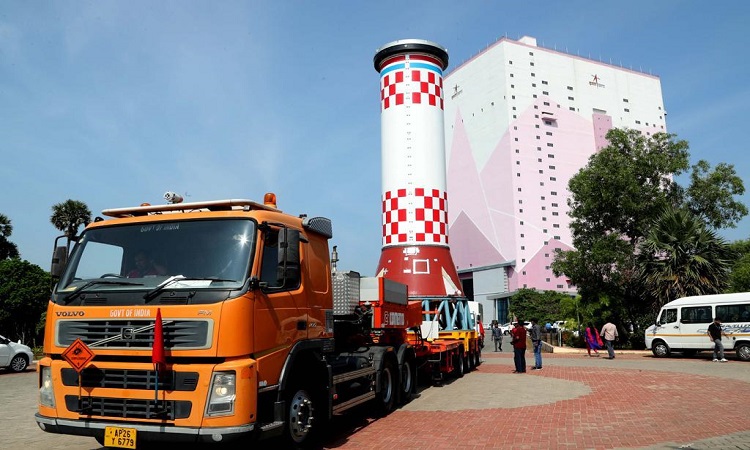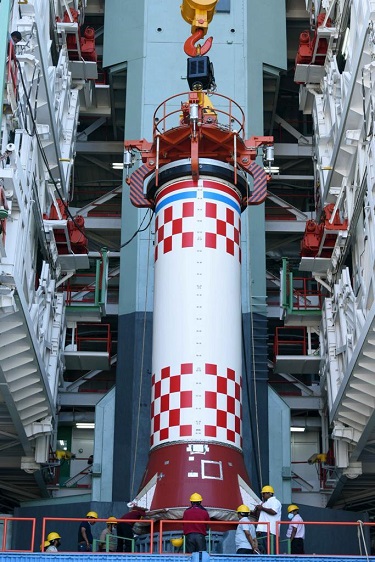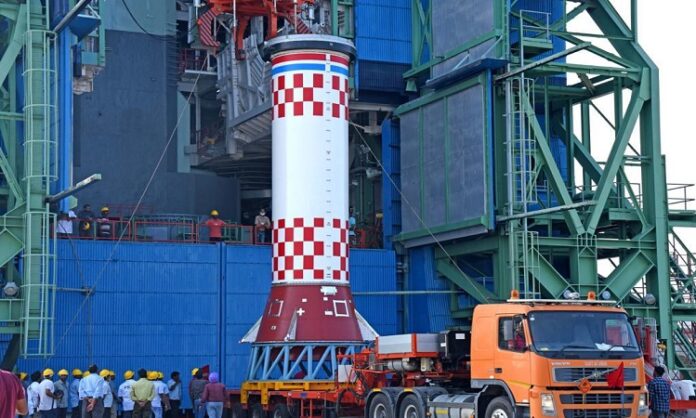Chennai: The India’s space journey is set to achieve another milestone with the Indian Space Research Organisation (ISRO) ready to plunge two satellites—earth observation satellite-2 (EOS-2) and a co-passenger satellite(AzaadiSAT)—into a low earth orbit (LEO) with the help of Small Satellite Launch Vehicle (SSLV) on Sunday.
The satellites, including the one prepared by about 750 girls from 75 different schools, will be taken off from Satish Dhawan Space Centre, Sriharikota, at 9.18 am by SSLV. The SSLV launch is aimed at catering to the demands satellite launch market.
The SSLV will carry a 142 kg EOS-02, equipped with an infrared camera with six metre resolution and a micro satellite (AzaadiSAT). During the countdown, propellant filling operations is being carried out in the 34 m tall, three-stage vehicle (all solid propulsion stages), which has a lift off mass of 120 tonnes, and all the rocket and satellite systems will be checked.
The satellite insertion will be achieved through a liquid propulsion-based Velocity Trimming Module (VTM) in the intended orbit. During the nearly 13 minute journey, the rocket will coast (will not be powered by engines), twice for about four minutes during the separation of the second and third stage and maintain its velocity using the thrust developed from the lift off, said an ISRO scientist.

About 742 seconds after the lift off, SSLV will inject the EOS-2 at an altitude of 356.30 km with an inclination of 37.21 deg to the equator. It will be followed by the separation and injection of AzaadiSAT about 50 seconds later.
SSLV is the new launch vehicle of ISRO capable of launching mini, micro or nano satellites (10 to 500 kg weight) to 500 km planar orbit. The design drivers of SSLV are low cost, low turnaround time, capable to accommodate multiple satellites, launch-on-demand feasibility, minimal launch infrastructure requirements etc.

EOS-2 satellite: It is intended to be used for cartographic applications at a cadastral level, urban and rural management, coastal land use and regulation, utilities mapping, development and various other GIS applications. The satellite carries two payload: a mid-wavelength and a long-wavelength infrared camera with a 6m resolution.
AzaadiSAT: As part of Azadi ka Amrit Mahotsav celebrations, an 8-kg satellite built by girl students across the country will be launched into space along with EOS-2. Indian National Space Promotion and Authorisation Centre (INSPACe) said in a tweet that the girl students involved in the development of the satellite will be “cheerfully looking at the maiden launch of India’s latest launch vehicle SSLV, as it carries their AzaadiSat onboard as a co-passenger
SSLV launch objective
ISRO scientists said that the SSLV has been designed to utilize the opportunities in small satellite market and provide launch-on-demand services to domestic and foreign customers. Unlike the Polar Satellite Launch Vehicles (PSLVs), SSLV is a smaller vehicle, which can be assembled with minimum resources and time. This mission is basically aimed at demonstrating technological capabilities of ISRO to deliver smaller payloads into LEO.
Also Read: Space emerges as new tourist destination for self-funded individuals
Weighing about 110-tons, the SSLV is the smallest space vehicle of the ISRO. The rocket can be assembled and integrated in just 72 hours against PLSVs, which takes around two months to reach the launch pad from the assembly building.
Cost of SSLV mission
 The Central Government had allocated ₹169 crores for the project, which included development & capability testing the vehicle systems and the flight demonstration through three development flights, SSLV-D1, SSLV-D2, and SSLV-D3. The current mission is the SSLV-D1 stage.
The Central Government had allocated ₹169 crores for the project, which included development & capability testing the vehicle systems and the flight demonstration through three development flights, SSLV-D1, SSLV-D2, and SSLV-D3. The current mission is the SSLV-D1 stage.
The Ministry of Science & Technology had stated that the ISRO was building the SSLV as a cost-effective launch vehicle with high launch frequency and quick turnaround capability in order to cater to the growing opportunity in the global launch services market for small satellites.
The ISRO had planned the SSLV-D1 launch in the first quarter of this year. However, the project got delayed due to the coronavirus pandemic and successive lockdowns.




